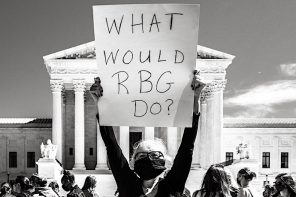Yesterday the Bush administration announced its proposal of a new federal regulation expanding the “conscience clause” right of refusal for medical workers that has been a topic of speculation in reproductive health and antiabortion circles since mid-July, when a leaked early draft of the proposal showed an alarmingly expanded definition of abortion as encompassing “any action blocking the implantation of a fertilized egg”: a move that would redefine many birth control methods as “abortion” in ways that the religious right has been increasingly advocating in recent years.
As the Guttmacher Institute notes:
Instead of clarifying the definition of abortion, in line with the consensus of the medical community and a long list of existing federal rules and regulations (including those issued by the Bush administration) that pregnancy begins after the implantation of a fertilized egg, it merely drops the definition entirely.
The complete proposal is available here, but what’s notable to me is not just the broadness of the definition of abortion and other ”objectionable activities” others have picked up on, but the corresponding broadness of the definition of health care entities that would be covered under the new proposal. As was the case when the Weldon Amendment was slipped into an omnibus spending bill in 2004, expanding a decades-old refusal clause in the Church Amendment that protected doctors and nurses in particular settings, such as a Catholic hospital, the current proposal will expand the definition of health care entities with the ability to object to a particular task from an individually dissenting doctor or nurse to a large-scale, impersonal corporation.
In keeping with the definitions in PHS Act § 245 and the Weldon Amendment, the Department proposes to define “health care entity” to include the specifically mentioned organizations from the two statutes, as well as other types of entities referenced in the Church Amendments. It is important to note that the Department does not intend for this to be a comprehensive list of relevant organizations for purposes of the regulation, but merely a list of examples.
Building on this broad definition, we propose that the term “health service program” should be understood to include an activity related in any way to providing medicine, health care, or any other service related to health or wellness, including programs where the Department provides care directly (e.g., Indian Health Service); programs where grants pay for the provision of health services (e.g., Administration for Children and Families programs such as the Unaccompanied Refugee Minor and the Division of Unaccompanied Children Services programs and HRSA programs such as community health centers); programs where the Department reimburses another entity that provides care (e.g., Medicare); and health insurance programs where federal funds are used to provide access to health coverage (e.g., SCHIP, Medicaid, and Medicare Advantage). Similarly, we propose that the term “health service” means any service so provided.
The total number of health care entities affected by the new proposal is 584,294, and includes 8,494 Residency Programs (accredited), 4,578 Health Insurance Carriers and 3rd-Party Administrators, 58,109 Pharmacies, 76,088 Grant awards, 57 State and territorial governments, 92 Pharmacy Schools, 2651 Nursing Schools, 234,200 Physicians Offices, 4,936 Hospitals, 11,856 Medical and Diagnostic Laboratories and thousands of other clinics, schools, home health care services, outpatient centers and nursing homes.
When the ACLU first tackled these issues in 2002, releasing a report on the tensions between respecting religious freedom and patients’ rights, it argued for a framework considering two factors: the weight of the burden placed on the patient, and the nature—sectarian or public—of the institution exercising the refusal. In the absence of clear Constitutional mandates on the issue, they suggested that:
First, policymakers should consider whether a particular refusal would place burdens on people who do not share the beliefs that motivate the refusal. The more the burdens fall on such people, the less acceptable any claimed right to refuse. Second, policymakers should consider whether a refusal would protect the religious practices of a sectarian institution or would instead protect an entity operating in a public, secular setting. The more public and secular the setting, the less acceptable an institution’s claimed right to refuse.
Likewise, the ACLU notes that not only is the list of objectionable services growing but that despite the claims of Health and Human Services Secretary Michael Leavitt that he never intended his proposal to affect contraception, the application of conscience clauses to issues of family planning and beyond predates this expansion by years: including the refusal of emergency contraception to rape victims in emergency rooms; the refusal of hospitals or doctors to perform a sterilization after cesarean section births, necessitating a separate surgery post-recovery; the refusal to distribute condoms in HIV/AIDS prevention; the refusal of insurers or employers to cover contraception; the refusal of pharmacists to fill contraception prescriptions; the neglect of religiously-affiliated managed care organizations to tell low-income women about their family planning options; the failure to train OB/GYN residents in abortions, sterilizations and contraceptive services before they go on to practice medicine, leaving them with incomplete skills to treat or refer their patients.
A commenter at Pandagon considers a further step: the refusal clause applied to antiabortion personnel working at facilities that provide abortions, such as Planned Parenthood, as a deliberate strategy to cripple providers and clinics financially and bureaucratically. It’s hardly a far cry from the tactics in use today.




